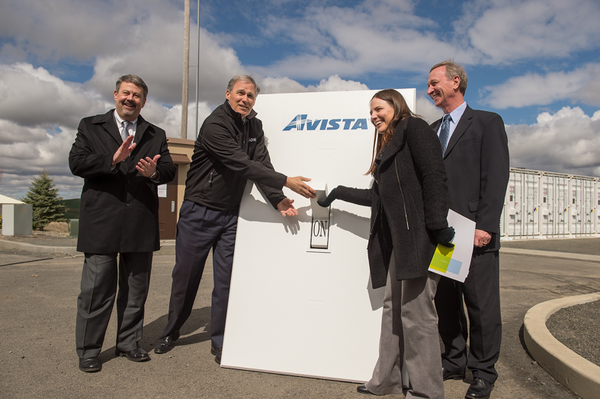This article was published in Scientific American’s former blog network and reflects the views of the author, not necessarily those of Scientific American
Last week, a panel of experts discussed the future of grid-scale energy storage at the ARPA-E Energy Innovation Summit in Washington, DC. On the panel was Heather Rosentrater with Avista – a medium-sized utility in rural Washington state that has spent the last 10 months testing a large vanadium-flow battery on its power grid to understand the system’s potential value.
Avista has been an investor-owned utility since 1889 and currently services a population of 1.5 million people in eastern Washington, northern Idaho and eastern Oregon. All told, their system covers 30,000 square miles, including both electricity and gas services.
Avista has recently spent $80 million to modernize its power grid, including both their own investment and matching funds from three grants from the U.S. Department of Energy through the American Recovery and Reinvestment Act (ARRA). Their continued investment in grid modernization includes Avista’s $7 million energy storage project in Pullman, Washington, which consists of a one-megawatt (MW), 3.2 MWh vanadium-flow battery system capable of powering 750 homes for a period of 3.2 hours. It’s the largest of its kind to be installed in North America or Europe.
On supporting science journalism
If you're enjoying this article, consider supporting our award-winning journalism by subscribing. By purchasing a subscription you are helping to ensure the future of impactful stories about the discoveries and ideas shaping our world today.
As an electrical engineer with almost 20 years of experience in the industry, Rosentrater oversees this energy storage project, among others. She started working with Avista as an electrical engineering student at Gonzaga University. She now serves as Avista’s Vice President of Energy Delivery. In this role, she works to see how technology can help her company to better serve its evolving customer base.

Heather Rosentrater, Avista VP of Energy Delivery
Below is an edited and condensed version of a discussion that I had with Rosentrater about what originally brought her to Avista almost 20 years ago, the biggest questions that her team is looking at today, and some of the lessons learned from their battery storage project since it was brought online 10 months ago.
Melissa C. Lott: What was it that initially brought you into the utility industry and made you think that Avista would be the type of place you would like to work?
Heather Rosentrater: Initially, it really was the innovation that the utility was showing, including in their fuel cell subsidiary – ReliOn – that was recently sold to Plug Power. I started out as a student in electrical engineering working at what was then Avista Labs and became ReliOn. I then worked as a technical engineer at the utility before moving into leadership on the electricity and gas side of the business.
Being on the cutting edge of renewable energy really excited me when I worked at the fuel cell subsidiary. When I later moved over to the utility side as a technical engineer and then into leadership, I saw that the same culture of innovation was really supported in the utility side of the company as well.
Lott: Do you think that this innovative spirit has grown over the past 20 years or has Avista moved away from this type of culture?
Rosentrater: I would say that this culture of innovation is in our DNA. Avista has been around for almost 127 years as a company and we have founded a number of innovative technology companies. As employees, we are encouraged to identify opportunities and problems that need to be solved. We are always looking at new technologies and how to access more data to try to solve those problems.
For example, we founded Itron back in the 1980s to figure out how to get energy bills to customers more quickly. It was originally about leveraging new technology to read the meters in the field and then give the customer the bill as soon as you read the meter. Then that morphed over time to the advanced metering infrastructure that they have today that is focused more on providing data to customers in a more real time manner and getting the operational efficiencies of not having that data brought back to a central location before going out to customers.
Another example is Ecova – a company that we had for about 20 years that we sold last year that really focused on advancing the use of data for customers. They have large customers such as Starbucks where they look at what stores are their best performers for utility costs, what they can learn from these best performers, and figure out what they can do to optimise their business.
I would say that, as a whole, innovation is a part of our DNA. But there are ebbs and flows across the industry that impact things – we saw this in the early 2000s when everything went back to the basics in the industry and we didn’t have this sustained innovation focus that we had historically and that we have again now.
Lott: What are some of the biggest challenges and problems that you are trying to pick apart now or have looked at in the past few years?
Rosentrater: There are really three categories that we are focused on right now in terms of questions.
One of those categories is customer engagement - how can we take advantage of technology to enhance customer engagement?
What we have really found here is that it’s about being able to offer different services based on a customer’s preference. So, some customers just want to get their bill whereas others want to be able to participate in the grid with their own generation and sell their excess generation to their neighbour. So, we ask ourselves how we can provide services to this entire spectrum of customers and be aware of their expectations going forward.
Another area that we focus on is the more technical side of grid operations – doing a lot of technology pilots and taking advantage of the U.S. Department of Energy’s American Recovery and Reinvestment Act (ARRA) grant funding, for example.
The third area that we focus on is workforce development – what can we do to encourage that culture of innovation in the company. I think that just by having a lot of these big projects here at Avista, we really inspire and encourage our workforce.
Lott: On the technology side – can you tell me a bit more about some of your pilot projects?
Rosentrater: In 2009, we built a central distribution management system that we can continue to build on. We put automation on our grid from smart transformers to switched transformer banks, and then we have built upon that with our energy storage and community solar projects.
We have also developed a grid team that looks at the different use cases for technologies, like our energy storage project, where we can use those batteries for applications like voltage support, managing peak load, optimally managing the price variances in the market, and supporting reliability – more on a neighborhood scale rather than a customer scale.
We think that, by utilizing all of these different use cases, we will be able to provide advantages over 3rd party or customer management of energy storage technologies. We call this “economies of scope” – leveraging these different use cases for a single device.
Lott: How are you using your vanadium-flow battery project, which came online 10 months ago, to figure out how to optimize its use? How are the batteries working out so far? Any surprises?
Rosentrater: This project has been really good for our own learning. For batteries integrating with the grid, the technologies have different characteristics in how quickly they charge and how they are going to discharge. We have been focusing on different test cases and understanding how the batteries respond in each of these test cases, which include the following:
Addressing the challenge of intermittent renewable energy – storing energy when it’s abundant to use when it’s needed
Identifying the best time to charge and discharge energy as efficiently as possible based on time of day and consumer needs
Examining how battery storage can enhance grid flexibility during peak times
Exploring how battery storage can improve reliability – for example if a feeder goes down
Exploring how battery storage can maintain constant voltage levels for power quality
Last summer, we had a couple of weeks of predicted really hot weather. So, we knew that we’d likely have a peak on our system and did an analysis to figure out which hours we could charge our batteries and when we would want to discharge our batteries. We were not only able to reduce our peak on that circuit by using the battery to offset our peak, but we were also able to understand the dollar value to deliver energy and receive energy for each hour in this scenario.
The battery operated just as we hoped it would and we learned more about how the battery works in the system. We are now putting a smart inverter on it to provide reactive VAR support onto the grid as well. And we are trying to test the value of each of these use cases.
The value of price arbitrage is probably the easiest one to put value on. We are trying to also find innovative ways to value the reliability and peak load reduction opportunities, the voltage and frequency support opportunities.
